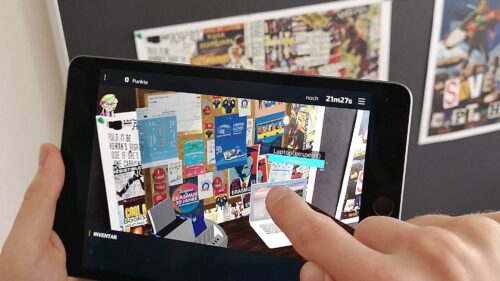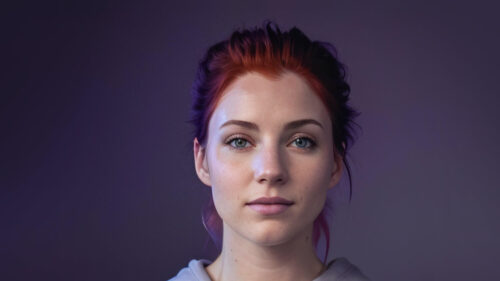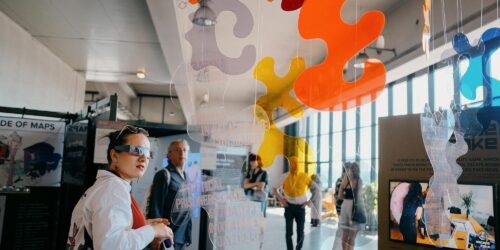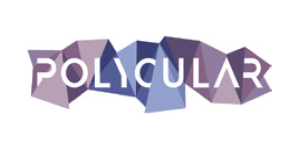Museums are special places. They are worlds within worlds, mirroring but also contradicting what lies outside of them. By exhibiting pieces of history, museums often pull together distant pasts, alternative presents and futures. In doing so, they make us question which moments in history were definitive tipping points.
In the augmented reality game Escape Fake, we play with these questions by creating the character Hannah, a quantum reality hacker, who tries to fix a broken future by preventing fake news from escalating at certain moments in time. But while Hannah has an overview of time, she cannot access certain points in time. She needs the players to work within their present, to trace down where the butterfly effect started. Indeed, as the notion of truth becomes more ambiguous in the age of AI, our most powerful strategy is to empower citizens to exercise their agency.
The Museum of Fake is placed in Hannah’s dystopian future. It is a dialogue between the interactive augmented reality experience and the artistic works which tackle the topic of disinformation from diverse and, sometimes, contradictory angles. In the Museum of Fake, visitors can look back at the year 2023, and reflect on the significance of historic events, technological change, or empathic communication for the trajectory of journalism and disinformation. The rest can only be up to them.
-

Escape Fake
Benjamin Arzt (AT), Tobias Hoffmann (AT), Thomas Layer-Wagner (AT), Irina Paraschivoiu (RO), Julian Watzinger (AT), Christoph Wörgerbauer (AT)
In a not-too-distant future, humanity is living in a post-truth world. The spread of fake news and deep fake tools used in political campaigns have created a broken, dystopian reality, where it is hard to distinguish what is real from what is not.
-
![HASHDOX [PROOF OF WAR]](https://ars.electronica.art/who-owns-the-truth/files/2023/08/hashd0x-c-egor_kraft-500x281.jpg)
HASHDOX [PROOF OF WAR]
Egor Kraft (RU)
Hashdox is a tactical software, designed to combat disinformation by enabling instant and spoof-proof on-chain evidence capture and forensics tools through registration of metadata and content hashing. Proof of War showcases a 3D model of the remnants of a house in the infamous city of Bucha, Ukraine.
-

Look out! Videos a year from now
Alex Lungu (RO), Ana Turos (RO)
Let’s use this cool filter! An AI replica tells you all about deepfakes and their endless possibilities. They transform from one person to another seamlessly. But wait, that cute photo you took is not that cute after all.
-

Ministry of Love and Empathy
Nóra Juhász (HU)
Ministry of Love and Empathy is a web-based project based on the psychology of disinformation and projective distortion of reality. The Ministry is a fake space: the virtual projection of a nonexistent governmental organ, which, in its illusory nature, reflects on the yawning gap in reality.
-

Moment of Truth
Elena Rabkina (BY)
This installation doubled by a card game challenges the ambiguous and often slippery notion of “truth”. Moment of Truth is a metaphorical exploration mirroring the different narratives we are exposed to through our own choices of media, as well as the content curation performed by algorithmic search engines and social media feeds.
About
Escape Fake 2.0 is an interdisciplinary project consortium with the aim of developing innovative digital tools for education on media literacy. We are doing this by curating an interdisciplinary approach focused on the design of immersive technology and interactive experiences, drawing on collaboration between organizations in the audiovisual / immersive technology, media, educational and cultural sectors.
Credits
Project lead: Irina Paraschivoiu
Curation: Irina Paraschivoiu, Thomas Layer-Wagner
Exhibition design: Susanna Vogel, Lukas Rettenbacher
Produced by Polycular
Partners: Expert Forum, La Fabbrica, Pro Progressione
Curation: Irina Paraschivoiu, Thomas Layer-Wagner
Exhibition design: Susanna Vogel, Lukas Rettenbacher
Produced by Polycular
Partners: Expert Forum, La Fabbrica, Pro Progressione
Museum of Fake is part of the project Escape Fake 2.0 and is co-funded by the European Union through the Creative Europe Programme and by the European Media and Information Fund managed by the Calouste Gulbenkian Foundation.


